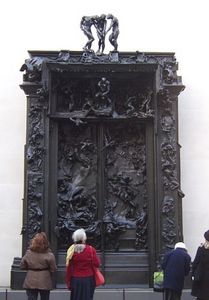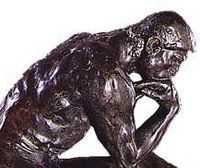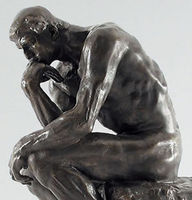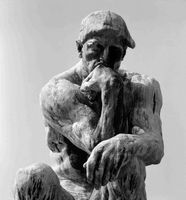The Thinker Analysis
- Date of Creation:
- 1881
- Height (cm):
- 71.50
- Length (cm):
- 58.00
- Width (cm):
- 40.00
- Medium:
- Metal
- Subject:
- Figure
- Art Movement:
- Impressionism
- Created By:
- Current Location:
- Paris, France
- Displayed at:
- Musée Rodin
- Owner:
- Musée Rodin
- The Thinker Analysis Page's Content
- Introduction
- Composition
- Use of Technique
- Mood, Tone and Emotion
- Textures
- Perspective
Introduction
The style which Auguste Rodin developed throughout his professional life can in part be attributed to his artistic education or the lack of it in any formal capacity. When the young Rodin was rejected from the prestigious École des Beaux-Arts he missed out on the Neoclassical training which was still very much part of the curriculum at the school during this period.
Without this strict training the artist was able to develop a much freer and more emotional style that would essentially be the making of his work. The Thinker is certainly a product of this unusual artistic development.
Rodin's The Thinker was originally part of The Gates of Hell which was completed on commission in 1882. What became known as The Thinker was originally intended to represent the poet Dante as he contemplated writing The Divine Comedy, on which The Gates of Hell was based.
When Rodin created this figure separately from the original work it lost its association with Dante and has become known all over the world as a symbol of philosophy and knowledge.
The Thinker Composition
Auguste Rodin created The Thinker in a way that mirrors the heroes of Michelangelo. The nude figure is muscular, taunt, and valiant. This demonstrates to the viewer the high regard with which Rodin held Dante and creative thinkers in general.
The seating of the figure is interesting as it immediately invokes the contemplative mood of this piece that would have been hard to create were the man stood up or looking out into the distance. The hunched torso is simple but adds to the sense of power that is apparent but by no means threatening. Rodin's brilliance at representing the character and feeling of his sitters is beautifully displayed here.
The Thinker Use of Technique
Often completing preliminary sketches and models, Rodin would then leave the carving of the full size marble to one of his assistants. Finally, the artist would take control of the work to add finishing touches and make sure that the piece fitted his exacting standards. This process is how The Thinker would have been developed.
The Thinker Mood, Tone and Emotion
The contemplative look of The Thinker gives this sculpture a feeling of calm and yet this piece is by no means a frivolous or relaxed piece. The Thinker conjures up images of intelligence and deep thought, themes that are universal in their appeal. Unlike some of Rodin's more complex or abstract works The Thinker is relatively simple in its design and this may go some way to explain its popularity.
The Thinker Textures
The Thinker was originally made in a much smaller form and when it was produced as a separate sculpture it was originally created in plaster. Bronze casts have been produced from the original ever since its completion. As Rodin became more successful he began to employ a host of assistants, all of whom had specific jobs to perform.
The Thinker Perspective
The original copy of The Thinker was not made on commission and therefore does not have an original place in which it was created to sit in the same way that other works by Rodin had. It's clear from the finish of the work however that this sculpture was supposed to be looked at in the round.
Many of the bronze copies, as well as the original plasters for this piece have been displayed in a central position so that visitors can see it from every conceivable angle.





